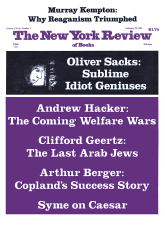When he was shown the manuscript of this paper, Israel Rosenfield pointed out that there are other arithmetics, higher and simpler than the “conventional” arithmetic of operations, and wonders whether the twins’ singular powers (and limitations) might not reflect their use of such a “modular” arithmetic. In a note to me, he has speculated that modular algorithms, of the sort described by Ian Stewart in Concepts of Modern Mathematics* (Chapter 3), may explain the twins’ calendrical abilities:
Their ability to determine the days of the week within an eighty-thousand-year period suggests a rather simple algorithm. One divides the total number of days between “now” and “then” by seven. If there is no remainder, then that date falls on the same day as “now”; if the remainder is one, then that date is one day later; and so on. Notice that modular arithmetic is cyclic: it consists of repetitive patterns. Perhaps the twins were visualizing these patterns, either in the form of easily constructed charts, or some kind of “landscape” like the spiral of integers shown on page 30 of Stewart’s book.
This leaves unanswered why the twins communicate in primes. But calendar arithmetic requires the prime of seven. And if one is thinking of modular arithmetic in general, modular division will produce neat cyclic patterns only if one uses prime numbers. Since the prime number seven helps the twins to retrieve dates, and consequently the events of particular days in their lives, other primes, they may have found, produce similar patterns to those that are so important for their acts of recollection. (When they say about the match-sticks “111–37 three times,” note they are taking the prime 37, and multiplying by three.) In fact, only the prime patterns could be “visualized.” The different patterns produced by the different prime numbers (for example, multiplication tables) may be the pieces of visual information that they are communicating to each other when they repeat a given prime number. In short, modular arithmetic may help them to retrieve their past, and consequently the patterns created in using these calculations (which only occur with primes) may take on a particular significance for the twins.
By the use of such a modular arithmetic, Ian Stewart points out, one may rapidly arrive at a unique solution in situations that defeat any “ordinary” arithmetic—in particular homing in (by the so-called “pigeon-hole principle”) on extremely large and (by conventional methods) incomputable primes (pp. 37–38).
If such methods, such visualizations, are regarded as algorithms, they are algorithms of a very peculiar sort—organized, not algebraically, but spatially, as trees, spirals, architectures, “thoughtscapes”—configurations in a formal yet quasi-sensory mental space. I have been excited by Israel Rosenfield’s comments, and Ian Stewart’s expositions of “higher” (and especially modular) arithmetics, for these seem to promise, if not “solution,” at least a powerful illumination on otherwise inexplicable powers, like those of the twins.
Such higher or deeper arithmetics were conceived, in principle, by Carl Friedrich Gauss in his Disquisitiones Arithmeticae, in 1801, but they have only been turned to practical realities in recent years. One has to wonder whether there may not be a “conventional” arithmetic (that is, an arithmetic of operations)—often irritating to teacher and student, “unnatural,” and hard to learn—and also a deep arithmetic of the kind described by Gauss, which may be truly innate to the brain, as innate as Chomsky’s “deep” syntax and generative grammars. Such an arithmetic, in minds like the twins’, could be dynamic and almost alive—globular clusters and nebulae of numbers whorling and evolving in an ever-expanding mental sky.
—Oliver Sacks
This Issue
February 28, 1985
-
*
Penguin, 1975.
↩



